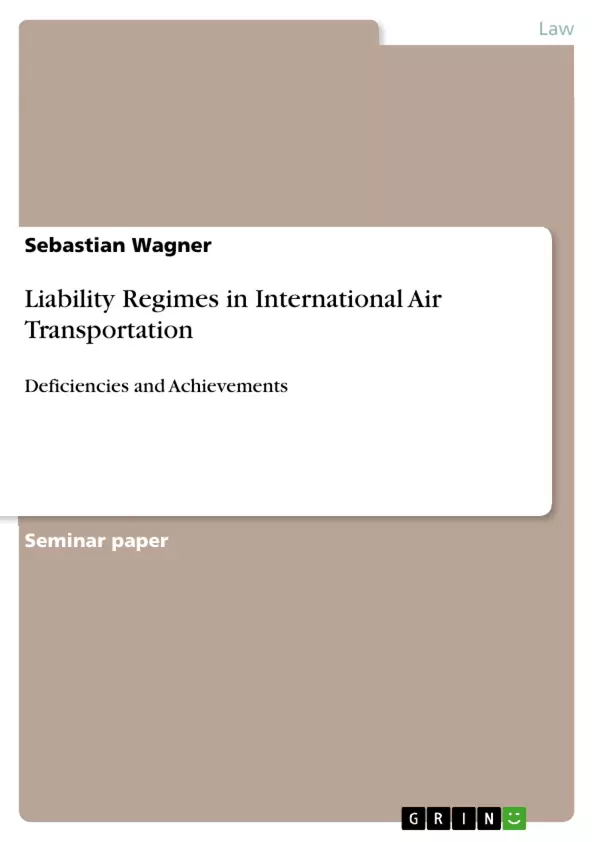The invention of aircraft is a magnificent piece of technology, which is a result of a long pro-cess of human effort. With the use aircraft for military purposes during World War I it was shown that aviation had great potential even in time of peace. The essential role of aviation industry in everyone’s life does not need any further explanation. Today's generations and those of the future have a quite natural interest in its development and safety. While flying offers various opportunities to mankind, at the same time, it is still a risky activity and acci-dents can be absolutely devastating. Even if aviation stands for one of the safest modes of transport, incidents will occur and people and airfreight will get damaged. The mentioned facts and the growing number and use of aircraft called for some kind of international regu-lation of aviation since from the very beginning (McNair 1964, p. 9).
In general aviation is a global business, which creates a need for international common rules. Over the years there have been quite many attempts to hold an international convention on the area. It was from upmost importance to create an adequate and uniform compensation system for the passengers and cargo but at the same to protect the infant aviation industry (Paulsson 2009, p. 6).
The subject of this paper is the regime of passenger liability in private international air law. This regime of liability is based on two global legal systems, represented by the ageing Warsaw System created from 1929 and the new Montreal Convention of 1999. The historical development and explanation of both systems, including their amendments and supplemen-tary instruments, acts as basis for this project paper.
In a second step I am going to deduce the necessities for the creation of the Montreal Con-vention. Then I will go into detail of its achievements and deficiencies concerning passenger liability in private international air law.
Finally the paper is closing with a short summery of the development of the general and in particular the legal liability issues of both main Conventions.
Inhaltsverzeichnis (Table of Contents)
- Introduction.
- The Evolution of the Regime of Liability.....
- Major Legal Instruments of Private International Air Law
- The Warsaw System
- Warsaw Convention..........\li>
- The Hague Protocol
- The Guadalajara Convention
- The Montreal Interim Agreement
- Guatemala City Protocol.
- The Four Montreal Protocols..\li>
- The Montreal Convention
- The Warsaw System
- Achievements and Deficiencies of M99
- Applicability and Documentation........
- Carriage of Cargo......
- Liability
- Insurance
- 5th Jurisdiction
- Conclusion............
Zielsetzung und Themenschwerpunkte (Objectives and Key Themes)
This paper investigates the legal regime of passenger liability in private international air law, analyzing the historical development and comparison of the Warsaw System and the Montreal Convention of 1999. The paper aims to demonstrate the need for the creation of the Montreal Convention by examining the achievements and shortcomings of its predecessor.- The evolution of liability regimes in international air transportation
- Comparison of the Warsaw System and the Montreal Convention
- Analysis of the deficiencies and achievements of the Montreal Convention
- Discussion of the necessity for the creation of the Montreal Convention
- Examination of passenger liability in private international air law
Zusammenfassung der Kapitel (Chapter Summaries)
Introduction:
The introduction provides context for the paper, highlighting the crucial role of aviation in today's world and the need for international regulation to ensure passenger safety and compensation in case of accidents. It also introduces the two primary legal systems governing passenger liability in international air law: the Warsaw System and the Montreal Convention.The Evolution of the Regime of Liability:
This chapter traces the historical development of liability regimes in international air transportation, starting with the Paris Conference of 1910. It examines the key events leading to the Warsaw Convention, emphasizing the growing need for international agreements to address the emerging concerns of aviation safety and passenger rights.Major Legal Instruments of Private International Air Law:
This section dives into the specific legal instruments that govern private international air law, focusing primarily on the Warsaw System and its amendments, including the Hague Protocol, Guadalajara Convention, Montreal Interim Agreement, Guatemala City Protocol, and the Four Montreal Protocols.Achievements and Deficiencies of M99:
The chapter examines the successes and shortcomings of the Montreal Convention, analyzing its applicability, documentation requirements, provisions regarding carriage of cargo, liability provisions, insurance aspects, and the concept of fifth jurisdiction.Conclusion:
The paper concludes by summarizing the development of liability regimes in international air transportation, highlighting the evolution from the Warsaw System to the Montreal Convention. It discusses the significant changes introduced by the Montreal Convention and its impact on passenger rights and air carrier liability.Schlüsselwörter (Keywords)
This paper focuses on the legal framework surrounding passenger liability in international air transportation, examining the historical evolution of regulations and the key legal instruments governing this area. The core concepts explored include international aviation law, the Warsaw System, the Montreal Convention, passenger rights, air carrier liability, and the development of international legal regimes.- Quote paper
- Diplom-Kaufmann Sebastian Wagner (Author), 2013, Liability Regimes in International Air Transportation, Munich, GRIN Verlag, https://www.grin.com/document/262352



